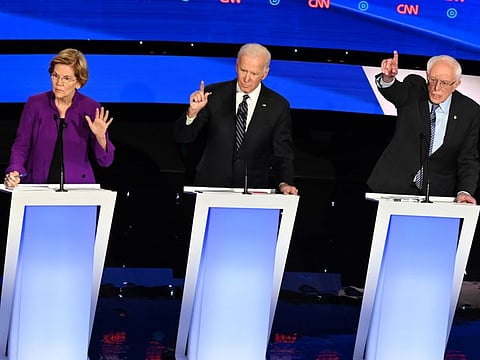Can history point to Democratic presidential victor?
Ahead of Iowa caucus on Monday, Biden and Sanders are seen as early favourites

With the Iowa caucus on Monday, the Democratic presidential contest is entering maximum election year velocity. While the outcome of the race remains highly uncertain, with multiple candidates who could yet win, history indicates there are patterns to previous races that potentially favour Joe Biden or Bernie Sanders.
The past few decades of US political history suggests the victor in nomination contests for both major parties frequently leads national polls of party identifiers on the eve of the first presidential nomination ballot in Iowa, which for the Democrats is this year on February 3, and/ or also raises more campaign finance than any other candidate in the 12 months prior to election year.
From 1980 to 2016, for instance, the eventual nominee in around half the Democrat and Republican nomination races contested (that is, in which there was more than one candidate), was the early front-runner by both of these two measures. This was true of Democrat Hillary Clinton in 2016; George W. Bush, the Republican candidate in 2000; Al Gore, the Democrat nominee in 2000; Bob Dole, the Republican candidate in 1996; Hillary’s husband Bill Clinton, the Democrat nominee in 1992; George H.W. Bush, the Republican candidate in 1988 and 1992; Walter Mondale, the Democrat nominee in 1984; and Jimmy Carter, the Democrat candidate in 1980.
Moreover, in at least four partial exceptions to this pattern, the eventual presidential nominee led the rest of the field on one of the two measures. This was true of Republican nominee Trump in 2016; Republican Mitt Romney in 2012, Democrat Michael Dukakis in 1988, and Republican Ronald Reagan in 1980.
While the circumstances of 2020 will be different from 2016, it is nonetheless the case that a drawn-out, divisive Democratic nomination contest may only benefit Trump presuming he is the Republican nominee again.Andrew Hammond
For instance, in the race for the 2016 Republican nomination, Trump led a majority of national polls of Republican identifiers from summer 2015 into election year in 2016. While he was not the leading fund-raiser from external donations among the Republican field, he was well positioned on the money side of the ledger too because the billionaire businessman self-financed much of his campaign before becoming the official Republican nominee in July 2016.
Turning to the Democratic contest in 2020, Joe Biden led national-wide polls for much of 2019, into the New Year too, and also raised in 2019 a lot of money — as would be expected by a former vice-president with extensive political connections right across the United States. Yet, it was socialist Senator Bernie Saunders (who was often second in national polls, and is also leading in a number of recent statewide polls in Iowa) who appears to have raised the most money overall in 2019, edging Biden to second place on this measure.
Frontrunners
On both the fund-raising and national poll measures, this points to Biden and Sanders as the early favourites. Yet, both have some key potential weaknesses, not least their respective ages of 77 and 78, and the race is therefore much more fluid at this stage than in 2016 which was Clinton’s contest to lose.
If either Biden or Sanders are selected, they would be the oldest presidential nominee in US history, and Sanders had a heart attack last year too. This is one reason why there is some speculation if either win the presidency, they may seek the White House for one term only and/ or announce much earlier than normal in the campaign cycle their preference for a (younger) vice-presidential running mate.
One of the key reasons, so far, that the age of Biden and Sanders has not been a bigger issue in the campaign is that, unless Trump is unexpectedly removed from office in his impeachment trial, they will be running against a president (aged 73) who is only a few years younger. So the age issue may therefore be neutralised in this election, and there is a real possibility of the first ever clash of septuagenarian Democrat and Republican candidates in US history.
One of the key factors that will influence Democratic prospects of defeating Trump will ultimately be whether, and how quickly, the party can unite around its eventual nominee.Andrew Hammond
While Sanders (who ran in 2016) and Biden (who ran in 1988 and 2008) are, by some measures, the early front-runners, they are not the prohibitive favourites that Clinton was in 2016, and the tide could yet turn decisively against them. Other Democrats who could yet ‘breakout’ decisively from the remaining pack in the upcoming contest include Senator Elizabeth Warren (70), ex-Mayor Pete Buttigieg (37), Senator Amy Klobuchar (59), and businessmen Michael Bloomberg (77), Tom Steyer (62) and Andrew Yang (45).
One of the key factors that will influence Democratic prospects of defeating Trump will ultimately be whether, and how quickly, the party can unite around its eventual nominee given the still significant amount of contenders, and ongoing debates within the party between centrists/ moderates such as Biden and Bloomberg and those favouring a more radical path to power in 2020, including Sanders and Warren.
While the circumstances of 2020 will be different from 2016, it is nonetheless the case that a drawn-out, divisive Democratic nomination contest may only benefit Trump presuming he is the Republican nominee again. Indeed, this may even prove the key tipping point in another tight general election contest in which the president already has the political ‘tail winds’ of an economy now in its longest ever growth cycle.
— Andrew Hammond is an Associate at LSE IDEAS at the London School of Economics.
Also Read: Democrats boost Trump’s border ‘emergency’
Sign up for the Daily Briefing
Get the latest news and updates straight to your inbox



